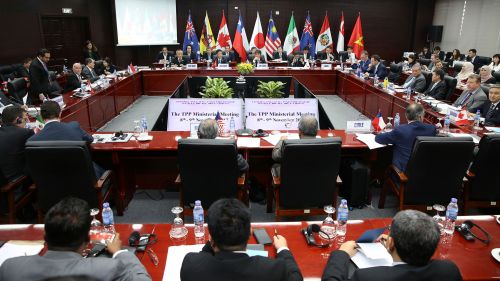CPTPP Countries March Forward in an Uncertain Trade Climate

The Comprehensive and Progressive Agreement for Trans-Pacific Partnership (CPTPP), is to be signed March 8—one year after the US stepped away from the Trans-Pacific Partnership (TPP).
A year after the United States removed itself from the 12-country Trans-Pacific Partnership (TPP), the newfangled TPP, now known as the Comprehensive and Progressive Agreement for Trans-Pacific Partnership (CPTPP), is to be signed March 8 in Santiago, Chile.
This is welcome news in the 11 remaining Asia Pacific capitals, and demonstrates to the world that global trade is not standing still in an era of increased protectionism. Yet the CPTPP still faces an uncertain path before it takes effect. What potential stumbling blocks threaten the accession of the agreement?
First, the CPTPP text must still be ratified by six of the eleven governments before it is put into force. In the negotiations over the past year, 22 provisions of the original TPP were suspended. Although many of those provisions had been pushed by the United States, several other countries requested suspensions or side letters on thorny issues. These included cultural exemptions for Canada, labor regulations for Vietnam, and rules on state-owned enterprises for Malaysia, to name a few.
Additionally, the new agreement represents only 13 percent of global GDP without the United States, as opposed to nearly 40 percent in the original TPP. This reduction creates two problems. Firstly, the overall effect on global trade standards, of which CPTPP is at the cutting edge, is significantly lessened, putting less pressure on non-CPTPP countries to adopt similar rules of trade. Secondly, CPTPP countries are now forced to make concessions and liberalize their domestic markets without gaining a massive export market in the United States.
But even without these changes, ratification still takes time. As an example, after the February 2016 signing of the original TPP, only one country (Japan) had ratified the agreement by the end of year. A similar delay could permit other disruptions to arise.
A potential interruption includes Canada and Mexico’s NAFTA renegotiation efforts. For both countries, ratification of the CPTPP is made more difficult without certainty in the direction of NAFTA talks with the United States. Equally problematic for Mexico are its impending June elections, where a trade-skeptic presidential candidate currently leading the polls presages potential obstinance to any CPTPP accession vote.
Navigating the Japanese Diet will also be critical, as Japan has been the driving force behind the rekindling of the agreement. The current government hopes to approve the CPTPP during the legislative session that ends in June, and Prime Minister Shinzo Abe is not wasting any time, planning to submit the proposal to ratify the pact yet this month. However, if there are delays with the Japanese government – far and away the largest economy participating in the CPTPP—cold feet could develop across the Pacific.
Finally, a potential setback could come from the Trump administration’s recent salvos suggesting that the United States is reconsidering the trade agreement, albeit under substantially different terms. Although some leaders have stated that the United States must accept the updated agreement, renewed interest may encourage enough CPTPP countries to hold out for a new negotiation. Further complicating matters, the United States is not alone in expressing interest toward the CPTPP. Other countries have made apparent their interest in the future of the agreement, from a post-Brexit United Kingdom to Taiwan.
Attention is not altogether a problem for a trade deal that was built to accept new member countries. But failing to seize the moment and ratify the agreement may once again create a liminal reality for the future of trans-pacific trade.

